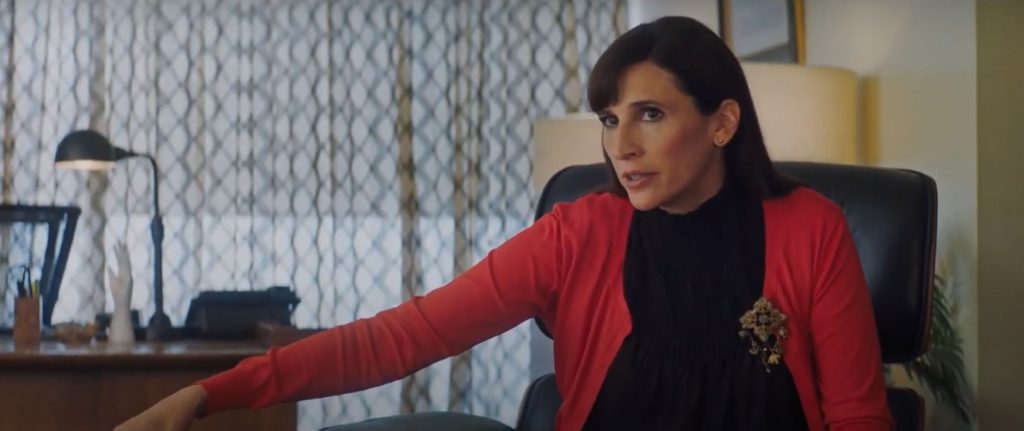July 18, 2020
by Carla Hay

Directed by David Wnendt
Culture Representation: Taking place in Norway and New York, the comedy/drama “The Sunlit Night” has an all-white cast of characters representing the middle-class.
Culture Clash: A female struggling painter artist from New York City takes a job as an apprentice to a grouchy and famous male painter artist, who lives as a recluse in Norway.
Culture Audience: “The Sunlit Night” will appeal primarily to people who like independent films that have plenty of quirky characters but not much substance.

When it comes to live-action comedy/dramas or “dramedies” that Jenny Slate stars in, it’s time for her to move on from playing the type of “stuck in a rut” woman who’s still living with her parents or still trying to launch a career, long after most people have already figured out what they want to do with their lives. (See 2017’s “Landline” and 2014’s “Obvious Child,” which is still the best movie that Slate has starred in so far. )
The dreadfully bland comedy/drama “The Sunlit Night,” starring Slate (who is long past her 20s, even though she looks younger than her real age), is yet another independent comedic film where she plays someone who gets a rude awakening that she has to start living her life like a responsible adult. In “The Sunlit Night,” Slate (who is one of the film’s producers) plays the character of Frances “Fran” Cohen, a New York-based painter artist who’s struggling to make a living from her art. German director David Wnendt makes his English-language film debut with “The Sunlit Night.”
In the beginning of the movie, Frances has recently broken up with her boyfriend Robert (played by Dan Puck) whom she’s been comfortably living with in the Hamptons. It’s implied that Robert was taking care of all of Frances’ financial needs, because now that the relationship is over, she’s suddenly found herself broke and homeless.
Frances has to move back in with her parents—Levi (played by David Paymer) and Mirela (played by Jessica Hecht)—at their cramped New York City apartment. She doesn’t share the details with her family about what went wrong in the relationship with Robert (and it’s not mentioned in the movie at all), but Frances’ parents assume that Robert was the one who ended the relationship. That assumption annoys Frances, although she doesn’t correct them.
Frances isn’t just upset about her love life. Her career isn’t going so well either. The opening scene of the film shows three pretentious art critics evaluating one of Frances’ art pieces that’s hanging on a wall, and making it clear that they don’t think the piece is good enough. One of the critics describes Frances’ work as “pedestrian,” as she sits uncomfortably in the room, listening to them while they give their negative reviews.
Frances has also recently gotten rejected for an artist residency in Tokyo. “Maybe I’m not an artist,” Frances says in a voiceover. “Maybe I’m just the daughter of two other artists.”
Frances’ mother Mirela (who designs upholstery textiles for well-to-do clients) and father Levi (who’s a medical illustrator) both make their livings as artists, but they have opposite personalities. Mirela is nurturing and supportive, while Levi is quick-tempered and tactless. Frances’ younger sister Gabriella, nicknamed Gaby (played by Elise Kibler), also lives in the apartment.
One evening, while the family is having dinner together, Gabriella surprises them with the news that she’s gotten engaged. Frances is happy for her sister, but Levi and Mirela aren’t thrilled because they don’t like her fiancé Scott Glenny. (The movie doesn’t go into details over why the parents disapprove of this relationship.) Levi immediately ruins Gabrielle’s big news about her engagement by announcing that he and Mirela are separating and they’re selling the apartment.
Feeling like her life is falling apart (and also desperately needing a new place to live), Frances jumps at the chance to work for a famous but reclusive artist named Nils Auermann (played by Fridtjov Såheim) in the remote Arctic district of Lofoton in Nordland, Norway. It’s only a summer job, and Frances has been warned that Nils can be very demanding and difficult (he fired the previous person who had the job), but Frances takes the opportunity anyway to be Nils’ apprentice.
Nils is painting a yellow mural on a local Viking Museum’s abandoned barn. He’s entered the project into a national arts competition. And he needs someone to help him finish painting the barn. The apprentice who has the job is required to live on Nils’ property.
When Frances arrives at Nils’ place, she immediately sees why he has an unpleasant reputation. He’s a rude and very self-centered taskmaster. And he immediately tells Frances that they will have long work hours (from 7 a.m. to 7 p.m.), and that she will only be allowed to work on her own art in her own free time.
Frances’ living arrangements are also less-than-ideal: She has to live in a small, messy trailer. A previous tenant has written this message on the trailer cupboards: “Welcome to Hell,” as a warning of what’s to come. Frances not only has to deal with culture shock, but she also has to adjust to Arctic Norway’s environment of the sun never really setting, even at night.
Frances covers and paints over the trailer windows in order to get some sleep. And she has some unexpected company with a young goat that keeps showing up in her trailer. Despite Nils being such a cranky and gruff boss, Frances feels a little bit of kinship with him, because art critics have used the same words to describe Nils’ art and Frances’ art: “lazy, cold, not working.”
In the nearby Viking Village, Frances visits the Viking Museum and meets an eccentric named Haldor (played by Zach Galifianakis, in yet another weirdo role), who’s the museum’s manager and who insists that people call him Chief. Haldor/Chief isn’t from Norway. He’s actually an American from Cincinnati, but he considers himself to be an expert on Norwegian culture and history—so much so, that he’s always dressed in a Viking outfit, and he stars in the museum’s short history videos that are shown in the museum’s visitor screening room. Frances is slightly amused by Haldor/Chief, which is more amused than most people watching this movie will be by this insufferable Viking wannabe character.
Nils has color-coded how the barn should be painted, while Frances says in a voiceover she’s the type of artist who prefers finger paint. Because he is very particular on how he wants the barn to be painted, Nils and Frances inevitably clash. When Nils loses his temper with Frances over how she painted part of the barn (too sloppily, in his opinion), he grabs her arm and yells, “The barn is like a cathedral to me!” Frances immediately defends herself and shouts back, “Don’t touch me ever!”
Frances storms off to get some time away from her aggressive boss. But defending herself from his physical harassment is a turning point in her relationship with Nils, because he now knows that she’s no pushover. Later, he makes a semi-apology to Frances by telling her: “You and I are complete opposites, Frances. I am not used to people … But we complement each other.”
One day, while driving with Nils in his car on a deserted road, Frances sees a solemn-looking man, who’s around her age, wearing a black suit and walking with a suitcase on the road. Frances asks Nils if they can offer the man a ride, but Nils says no.
Frances sees the mysterious suit-clad man again at a local diner. She begins talking to him and tells him that she’s sure that she’s seen him before in New York. And by the way she looks at him, it’s obvious that she’s very attracted to him and interested in getting to know him better. This sad-looking man acts very aloof with her, and he rebuffs her attempts at a friendly conversation.
Frances sees him again later at the Viking Museum. And this time, she finds out who he is and why he’s in Norway. His name is Yasha (played Alex Sharp), and it turns out he really is from New York. Yasha is in Norway because his Russian immigrant father, whom he worked with at his father’s bakery in New York, has died, and Yasha is fulfilling his father’s wish to have a traditional Viking funeral in Norway.
And where is Yasha’s mother? Her name is Olyana, and she stayed in Russia, and never immigrated to the United States, as Yasha and his father had hoped. Yasha is very estranged from his mother, and he hasn’t invited her to the funeral. But that doesn’t stop Olyana (played by Gillian Anderson) from showing up anyway.
The biggest problem with “The Sunlit Night” is that it’s a lot duller than it should be. Galifianakis usually plays goofballs who are supposed to be annoying, but his Haldor/Chief character in this movie has no moments that are truly funny. It’s almost as if he’s there as filler. Anderson does a Russian accent that isn’t very convincing, while the Yasha character is just a grieving shell of a man, so he doesn’t have much of a personality.
The relationship between Frances and Nils, which is supposed to be the center of the story, seems devoid of anything memorable, except for the scene where they have a physical confrontation. There are a few pretentious moments when Frances namechecks some famous fine-art pieces in comparisons to her current life situation, but only art buffs will really appreciate some of these semi-humorous references. And even the “romance” scenes in the movie fall flat.
Rebecca Dinerstein Knight adapted “The Sunlit Night” from her 2015 novel of the same title. The book is based on her own “fish out of water” experiences as a New Yorker living in a remote part of Norway. But what works in a book doesn’t always work in a screenplay, since the pace of “The Sunlit Night” moves as slowly as a glacier moving through the Arctic.
An example of what’s wrong with this movie is how it mishandles a possible friendship between Frances and a bored Coop Prix supermarket worker (played by Luise Nes), whom Frances randomly meets at the supermarket in the frozen-food section. (This supermarket worker says her name is Kay, but she is identified in the film credits only as “Fridge Girl.”) Frances asks this young woman if she would like to pose for a painted portrait for Frances. Fridge Girl says yes, and immediately walks out of her job that day to go with Frances, without telling her boss or co-workers.
The next thing you know, Fridge Girl is posing nude for Frances in Frances’ dumpy trailer. Who does that? The movie never bothers to answer that question, because there’s no insight given into Fridge Girl’s character and why she’s the type of person to just impulsively walk out of a job to go with a stranger to pose for a nude portrait in a dingy trailer in the middle of nowhere.
Although the movie shows that Fridge Girl has posed for multiple nude portrait sessions for Frances, there’s no real inkling of what kind of conversations they might have had outside of those portrait sessions. Viewers don’t get to see the development of a possible friendship between the supermarket worker and Frances. Instead, viewers see more of Fridge Girl’s naked breasts than her personality.
Another thing about the movie that’s a missed opportunity is how little of Norwegian culture it shows, except for over-the-top Viking stereotypes that are played for laughs. Frances doesn’t seem very curious about getting to know other local artists who might live in the area, or even traveling in her free time outside of the stifling atmosphere of working with Nils. (Going to a local diner and a local grocery store doesn’t count.)
Maybe Frances’ lack of interest in exploring more of Norway is an example of how shallow she is or maybe how lazy the screenwriting is in not making the book more interesting for the movie. Conveniently, Frances’ “love interest” just happens to be a fellow New Yorker who’s in Norway. If you were to believe what’s presented in this movie, Norwegian men just aren’t interesting enough for Frances.
And did Frances really mature emotionally from this experience? What happens when her summer apprenticeship with Nils ends? Those questions are answered in the movie, but the conclusion isn’t particularly insightful.
Frances has the type of arrested-development lifestyle that might be somewhat cute when you’re in your 20s. But it’s not cute when you’re way past that age. If people want to see a comedy/drama film about a struggling female artist who recently broke up with her boyfriend, moves back in with her parents in their New York City apartment, and has a younger sister whose life is going more smoothly than hers, then writer/director/actress Lena Dunham already made that a much-better movie with “Tiny Furniture.”
Quiver Distribution released “The Sunlit Night” on digital and VOD on July 17, 2020.
https://www.youtube.com/watch?v=z-twMQ4SOuE


